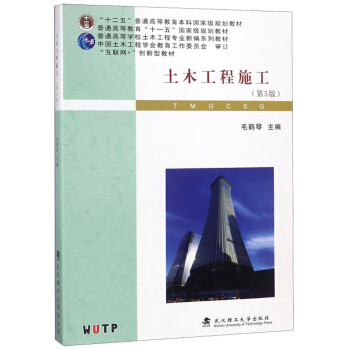材料概论(双语版)(第2版)
作者: 水中和
出版时间:2014年9月
出版社:武汉理工大学出版社
- 武汉理工大学出版社
- 9787562946304
- 52523
- 0051155467-7
- 2014年9月
- TB3
- 无机非金属材料类
- 本科
本书既可供高等学校材料类学科专业作为双语教学的课程教材,又可供从事材料科学研究与工程技术应用的专业人员作为了解专业知识、提高英语水平的阅读材料,还可作为高等职业技术院校相关专业的教学用书,以及材料类学科专业来华留学生的学习用书。
Chapter 1 Basic Knowledge on Materials
1.1 An Brief ITlstory of Materials
1.2 Definition and Classification of Materials
1.2.1 Definition of Materials
1.2.2 Inorganic and Non-rnetallic Materials
1.2.3 Metallic Materials
1.2.4 Polymer Materials
1.2.5 Composite Materials
1.3 Substances, Resources and Materials
1.4 Relationship between Structure, Properties and Processing of Materials
1.4.1 Property
1.4.2 Structure
1.4.3 Processing
1.4.4 Structure-processing-property Relationship
1.5 Material Science and Engineering
1.5.1 Materials Science
1.5.2 Materials Engineering
1.6 Latest Development and Tendency of Materials
Chapter 2 Inorganic Non-metallic Materials
2.1 Ceramics
2.1.1 Introduction
2.1.2 Structure of Ceramics
2.1.3 Ceramics Processing
2.1.4 Properties of Ceramics
2.1.5 Applications of Ceramics
2.2 Glass and Its Products -
2.2.1 Glasses
2.2.2 Preparation of glass
2.2.3 Properties of Glass
2.2.4 Applications of Glasses
2.3 Cement and Concrete
2.3.1 Portland Cement
2.3.2 Hydration of Cement
2.3.3 Concrete and its Preparation
2.3.4 Properties of Concrete
2.3.5 Progress in Cementitious Materials
Chapter 3 Metallic Materials
3.1 Types of Metal Alloys
3.1.1 Iron and Steel
3.1.2 Nonferrous Metals
3.1.3 Phases
3.2 Structure
3.2.1 Solid solutions
3.2.2 Grain structure
3.2.3 Crystalline structure
3.3 Properties
3.3.1 Plastic deformation in metals
3.3.2 Mechanical and physical properties of metals
3.4 Fabrication of Metals
3.4.1 Forming Operations
3.4.2 Casting
3.4.3 Miscellaneous Techniques
3.5 Metal Corrosion
3.5.1 Corrosion
3.5.2 Protection Methods
3.6 Applications of Metals
3.6.1 Used as Structural Materials or Components
3.6.2 Metals in Electrical and Electronics Applications
3.6.3 Metals in Aerospace
3.6.4 On the Road: Metals in Transportation
3.6.5 Metals and Medicine
Chapter 4 Polymer Materials
4.1 Classification and Molecular Weight
4.1.1 Basic Terms and Definitions
4.1.2 Classification and products
4.1.3 Molecular Weight
4.2 Structural Features
4.2.1 Configuration and Conformation
4.2.2 Structure-Property Relations
4.3 Basic Properties
4.3.1 Mechanical Properties
4.3.2 Solution Properties
4.4 Preparation and Processing Technology
4.4.1 Polymer Synthesis
4.4.2 Polymerization methods in industry
4.5 Applications of Polymers
4.5.1 The Power of Plastic
4.5.2 Greener Plastics from a Greenhouse Gas
Chapter 5 Composite Materials
5.1 Introduction
5.1.1 Development History
5.1.2 Def'mition of Composite Material
5.1.3 Classification of Composite Material
5.2 Constituents of Composite Materials
5.2.1 Matrix
5.2.2 Reinforcement
5.2.3 Fiber Architecture
5.2.4 Conformation and Structure of Reinforcement
5.3 Properties and Design of Composites
5.3.1 Mechanical Properties of Resin-based Composites
5.3.2 Isotropic and Anisotropic
5.3.3 Rule of Mixtures
5.3.4 Design of Composites
5.4 Fabrication of Composites
5.4.1 Surface Treatment of Reinforcement
5.4.2 Polymeric Composites
5.4.3 Metal Composites
5.4.4 Ceramic Composites Manufacture
5.4.5 Carbon/carbon Composites
5.5 Application of Composites
5.5.1 Application in Defense and Military Industry Area
5.5.2 Application in Aerospace Vehicles
5.5.3 Transport Application
5.5.4 Application in Energy Saving and Environment Protect Fields
Chapter 6 Functional Materials
6.1 New Energy Materials
6.1.1 Fuel Cells Materials
6.1.2 Lithium-ion Batteries Materials
6.1.3 Solar Cells Materials
6.1.4 Hydrogen Storage Materials
6.1.5 Thermoelectric Materials
6.2 Nanomaterials
6.2.1 Type of Nanomaterials
6.2.2 Characteristics of













